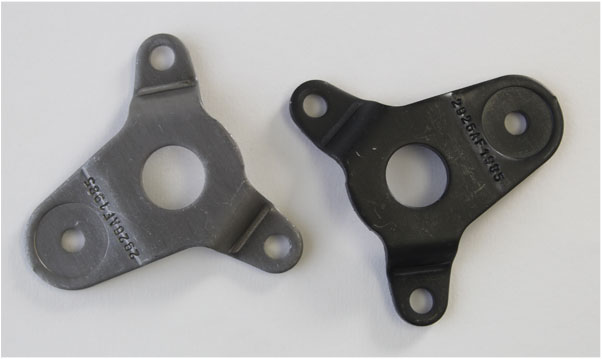sales@amperemetal.com (905)629-0909 Mon-Fri, 8am until 4:30pm
ISO 9001 : 2015 Certified Registered with Canada's Controlled Goods Program

To view properties and benefits of black oxide click here.
The black oxide process is a chemical conversion coating that offers mild corrosion protection, along with a number of other benefits. This means that the black oxide is not deposited on the surface of the substrate like nickel or zinc electroplating. Instead, the black oxide coating is produced by a chemical reaction between the iron on the surface of the ferrous metal and the oxidizing salts present in the black oxide solution. These oxidizing salts include penetrates, catalysts, activators and proprietary additives which all take part in the chemical reaction. The result of this chemical reaction is the formation of black iron oxide, magnetite (Fe3O4), on the surface of the metal being coated.
One of the advantages of black oxide is that it produces no significant dimensional change. Because the process is strictly a chemical reaction, there are no high or low current density areas to cause uneven coating thicknesses, as is typical with electro-deposited finishes. Black oxide coatings produce a uniform coating over the entire surface area of the metal. The oxide formation penetrates into the surface of the metal from 5 to 10 millionths of an inch.
While black oxide makes claim that no dimensional change occurs, the fact is that there is a minute build up that takes place. This build up is about equal to the depth that the coating penetrates into the surface of the metal (5 to 10 millionths of an inch). This increase is so small, however, that it is unlikely to affect most dimensional tolerances. The black oxide finish will not chip, peel, or rub off.
While black oxide finishes are not suitable for severe corrosion environments and can not replace phosphate coatings or plated finishes, except where lower corrosion resistance is allowed, it is a cost-effective process with aesthetic appeal for the proper application.
Black oxide has a range of unique properties and benefits that can be applied to a variety of industries.
Applying a supplementary post treatment after the black oxide finish increases the corrosion protection properties of black oxide coatings. Alone, black oxide offers only a very mild corrosion resistance. A properly applied post treatment, allowing full absorption of the supplementary coating into the pores of the black oxide finish, enhances the corrosion protection to the metal, while producing a deeper black appearance. An appropriate post treatment also increases the resistance to abrasion of the black oxide where break-in of mating parts are required.
Oil post treatments are frequently used after black oxide coating. The oil can be either water-soluble or solvent-based and can be controlled to allow a heavy oil film on the part or so that the part is virtually dry to the touch. Of course, less oil means less corrosion protection. A clear wax or acrylic may also be used as alternatives where absolutely no oil film is desired.
To view properties and benefits of black oxide click here.